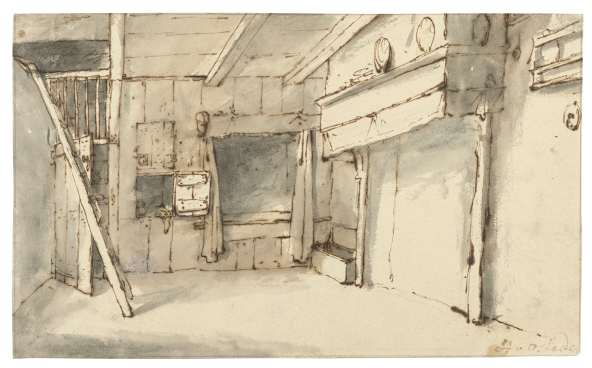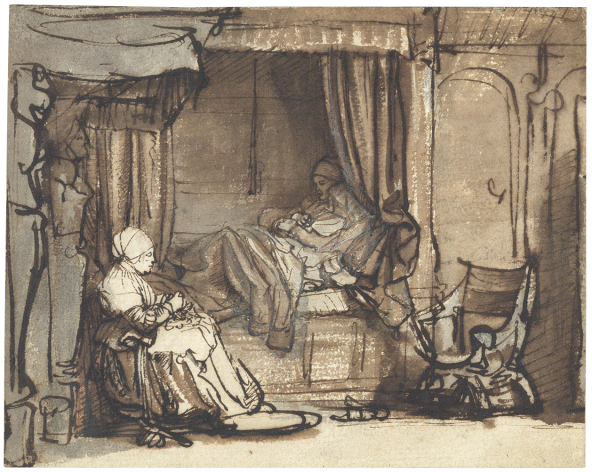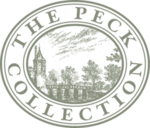Choose a background colour
Thomas Wyck, Dutch, 1616-1677
:
Interior with Bed, c. 1650-60
Gray wash over black chalk on paper; framing lines in brown ink.
6 3⁄16 × 7 7⁄8 in. (15.7 × 20 cm)
Verso, lower left, in pen and ink, A. Vander Velde (likely by an eighteenth-century hand), and lower right, A. van der Velde fec’t (by an eighteenth- or nineteenth-century hand).
- Chain Lines:
- Vertical, 24 mm.
- Watermark:
- Foolscap with Seven Bells Foolscap (showing only fi ve of the bells, and a pendant with three circles).
- Provenance:
Van Puten, Paris, before 1829 (Lugt 2058, mark on verso); his sale, Paris, 14– 15 December 1829 (as Adriaen van de Velde); sale, Christie’s, Amsterdam, 12 November 1990, lot 129; Sheldon and Leena Peck, Boston (Lugt 3847); gift to the Ackland Art Museum, inv. no. 2017.1.97
- Literature/Exhibitions:
None.
- Ackland Catalogue:
- 2017.1.97
Sunlight cascades through lead glass windows to illuminate a recently occupied bed, a scene depicted by the artist almost entirely using a brush and gray wash, or diluted ink. Since dedicated bedrooms were rare in seventeenth-century Dutch homes, people slept in bedsteads. Such sleeping quarters were surrounded by wood planking and set into a corner or wall of a room and were furnished with curtains for warmth and privacy. Its focus as the subject matter of a drawing, rather than as a background element in a broader composition, is unusual, suggesting that Thomas Wijck kept it in his studio for later use.
This attractive study, executed almost entirely with a brush and wash, imparts a charming sense of tranquility. It gives the impression that the artist himself slept in this bed and decided to make this study after waking up, carefully draping the curtain around the back of the chair before picking up the tools of his trade. The bed is more properly called a bedstead (bedstede or bedstee), a common type found in many houses at the time. The wood planking encloses the space into a corner or wall of a room, with a curtain and valance added for additional privacy and warmth.1
Dedicated bedrooms (slaapkamers) were actually quite rare at the time.2
Such bedsteads could be found in any number or type of room in Dutch houses, even in kitchens or common areas, though given the angled gables around the window here, this particular room appears to be on an upper level of a more urban structure, or a village inn.
A bedstead is a highly unusual type of stand-alone subject matter in Dutch art. One of the closest related examples can be found in a drawing by Cornelis Bega (c. 1631/32 – 1664) showing a similar bedstead in what appears to be a room in a large farmhouse barn (stolpboerderij) with a hearth used for cooking in the same space Fig. 49.1.3

Cornelis Bega, Farmhouse Interior, c. 1648 – 50. Pen in brown ink and brush in gray and brown ink, 152 × 252 mm. Amsterdam, Rijksmuseum, inv. no. rp-t-00-211.
Rijksmuseum, Amsterdam
Even in Bega’s case, however, the focus remains more on the whole room rather than the bed itself. Beds and bedsteads are more commonly encountered as background elements in artworks populated with one or more figures. Some of the best examples can be found in Pieter de Hooch’s (1629 – 1684) genre paintings set in interiors of well-to-do burgers’ houses, also datable to the 1650s.4
Closer to home in Thomas Wijck’s case are the numerous drawings and paintings by fellow Haarlem artist Adriaen van Ostade (1610 – 1685), who frequently added a bedstead in the background of his low-life images of rowdy or relaxing peasants.5
Both Wijck and Bega are presumed to have been students of Van Ostade, and they may have adopted the practice of making studies of interiors from him. A drawing by Rembrandt (1606 – 1669) showing his wife Saskia in bed, attended by a woman seated next to her, is probably the best-known seventeenth-century Dutch image containing a bedstead Fig. 49.2.6

Rembrandt, Interior with Saskia in Bed, c. 1640 – 42. Pen in brown ink and brush in brown and gray wash, with additions in red and black chalk, 142 × 177 mm. Paris, Fondation Custodia, Frits Lugt Collection, inv. no. 266.
Fondation Custodia, Collection Frits Lugt, Paris
Dated on stylistic grounds to circa 1640 – 42, Rembrandt must have made this drawing just after he and Saskia moved to their house on the Joodenbreestraat, and her presence in bed may relate to one of her childbirths around that time.7
This image was one of the main sources used to reconstruct the large back room (achterkamer or sael) in the Rembrandt House Museum, which includes a replica of a bedstead that can be seen there today.8
While the Peck drawing is unsigned and previously unpublished, the attribution to Wijck can be made on the basis of stylistic comparison with a group of similar drawings of interiors. Some of these, as Maud van Suylen pointed out, were used by the artist to compose backgrounds in his genre paintings.9
While his interior studies are sometimes slightly looser and sketchier than in the present work, his characteristic handling of the brush can clearly be found here, especially in the liquid handling of the joints between the planks, and in the various tones he uses to create texture in the stucco walls.10
Unlike Van Ostade and Bega, Wijck completely eschews the use of a pen for these studies, preferring to work with a brush over a black chalk underdrawing. Van Suylen theorized that Wijck kept a portfolio of drawings of such interiors for studio use.11
The present work probably once belonged to this group of studies, all of which are likewise unsigned. Dating this body of drawings is challenging since none of the interior drawings or their related paintings bear dates, but they were probably made in the latter part of his career, after his return from his presumed trip to Italy.12
The seven-pointed foolscap watermark in this sheet also points to a date after 1650.
End Notes
Fock 2001, 62, 79, 128.
M. Westermann in Newark & Denver 2001 – 02, 30.
For this drawing, see Fock 2001, 79; and Scott 1984, 427, no. D223. Despite bearing an old (non-autograph) signature of Adriaen van Ostade, the attribution to Bega is convincingly made on the basis of comparison with a signed drawing of a kitchen interior formerly in the Victor de Stuers collection (https://rkd.nl/explore/images/285091).
See Sutton 1980, passim .
See, for example, Schnackenburg 1981, nos. 41, 92, 219, 234, 239.
Schatborn & Hinterding; and Benesch.
Schatborn 2010, no. 10.
For commentary on this reconstruction, see Chapman 2015, 208.
Workshop Interior, a drawing in the Metropolitan Museum of Art, New York (inv. no. 2005.418.26), is particularly close in style and was used for the background of at least two of Wijck’s paintings; see Van Suylen 2020, 198 – 99, figs. 5 – 7.
Van Suylen 2020, 198, 203.
For the years of Wijck’s travels and documented interims in Haarlem, see I. van Thiel-Stroman in Biesboer et al. 2006, 347 – 49.
